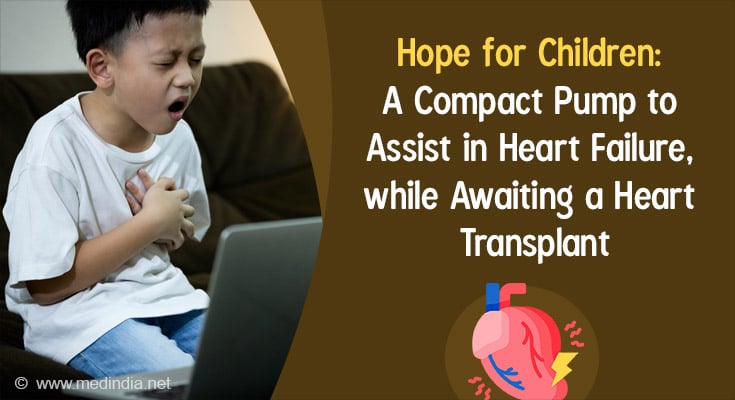- A compact pump was designed to enable children suffering from heart failure to lead regular lives as they wait for a transplant
- The new pump, a ventricular assist device, is slightly larger than an AA battery and is suitable for implantation in children weighing as low as 18 pounds
- This pump can improve the lives of children needing heart transplants, allowing them to stay at home instead of being hospitalized
A novel surgically implanted pump designed to assist a child’s failing heart has successfully completed the initial phase of human testing in a trial led by Stanford Medicine. This would assist children in need of heart transplants while allowing them to remain at home instead of in a hospital setting (1✔ ✔Trusted Source
Small pump for kids awaiting heart transplant shows promise in Stanford Medicine-led trial
)..
This newly developed ventricular assist device (VAD), is a pump implanted into the heart to enhance its blood-pumping function for individuals suffering from heart failure, providing a valuable window to seek a suitable donor heart. This innovative device has the potential to address a critical need in pediatric heart transplant treatment.
A study conducted by the Stanford School of Medicine, in collaboration with various medical centers in the United States, involved a feasibility trial with seven children who were provided with a new pump to assist their deteriorating hearts. Out of these participants, six eventually underwent heart transplants, while one child’s heart managed to recover, eliminating the need for a transplant.
After a successful heart transplant, children can lead normal and healthy lives once fully recovered. They can typically return to school activities within three months of the surgery and gradually resume sports and other extracurricular activities. #hearttransplant #pump #medindia’
Advertisement
Advantages of the New Pump Against the Previous Pump
If the initial findings are validated in a more extensive clinical study of the device, the process of waiting for a heart transplant could potentially be made more convenient for young children and their families. The recently developed pump, called the Jarvik 2015 ventricular assist device, is slightly larger than an AA battery, and can be surgically implanted in children weighing as little as 18 pounds. After implanting the implant, children can engage in various regular activities while they await a suitable heart for transplantation (2✔ ✔Trusted Source
Heart Transplant
).
.
In contrast, the ventricular assist device accessible for aiding small children with failing hearts is the Berlin Heart, which is not designed for implantation. This device, resembling a large suitcase in size, weighs between 60 and 200 pounds, varying according to the model. It is connected to the child through two cannulas, each nearly as wide as garden hoses.
The Berlin Heart poses a significant stroke risk and typically necessitates hospitalization, leading to prolonged stays for children awaiting a heart transplant. Consequently, the burden on children is much greater than that on adults implanted with heart pumps, who are often discharged from the hospital with similar diagnoses.
The pediatric cardiologist Christopher Almond, MD, professor of pediatrics at Stanford Medicine and the study’s lead author said, “While we are extremely grateful to have the Berlin Heart, a life-saving device, ventricular assist devices for adults have been improving every decade, but in pediatrics, we’re using technology from the 1960s,”.
The chief of cardiology at Children’s Healthcare of Atlanta, William Mahle, MD, serves as a senior author of the study.
Advertisement
What Necessitated the Study?
Implantable ventricular assist devices have been accessible to adults for over four decades, as outlined by Almond. These devices are designed to fit inside the patient’s chest, offering a safer and more convenient alternative to external devices such as the Berlin Heart. Patients can resume their daily activities, including going to work or school, taking walks, and even riding bicycles (3✔ ✔Trusted Source
Four Decades of Saving Kids’ Hearts: Stanford Medicine Children’s Health Celebrates its 500th Pediatric Heart Transplant
).
Almond commented that the delay in pediatric technology poses challenges for other medical devices aimed at assisting children with heart conditions, as well as for the field of pediatrics as a whole. He said, “There’s a huge difference in the medical technology available to kids and adults, which is an important public health problem that markets have struggled to fix because conditions like heart failure are rare in children.”
Medical device companies have little incentive to create smaller pumps for children due to the low demand for pediatric heart transplants. However, the lack of miniature ventricular assist devices for children burdens the healthcare system. Children using the Berlin Heart face high medical costs and occupy specialized cardiovascular care units for prolonged periods, potentially reducing availability for other patients.
Advertisement
Study Details and Encouraging Preliminary Findings
The pilot study for the Jarvik 2015 ventricular assist device involved seven pediatric patients suffering from systolic heart failure. This condition impacts the heart’s primary pumping chamber, the left ventricle, responsible for circulating blood throughout the body. Among the participants, six children had systolic heart failure due to dilated cardiomyopathy, a condition characterized by the enlargement and weakening of the heart muscle leading to improper pumping. One child’s heart failure was attributed to a complete heart block caused by lupus, an autoimmune disease. It is worth noting that all children enrolled in the trial were awaiting a heart transplant.
Every child underwent a surgical procedure to have a Jarvik 2015 device implanted in the left ventricle, the heart’s main pumping chamber. Along with this, each child was prescribed medication to reduce blood clotting and decrease the possibility of a stroke. The children were aged between 8 months and 7 years and weighed between 18 and 46 pounds when they received their pumps. The pump is suitable for children weighing up to 66 pounds.
Physicians consider that if the medical regulators permit the use of a new pump, approximately 200 to 400 children around the globe would be eligible to benefit from its application annually.
The trial aimed to evaluate if the pump could sustain patients for a minimum of 30 days without experiencing any malfunction or resulting in a severe stroke. In addition, the researchers gathered initial safety and performance data to aid in developing a more extensive pivotal trial, which could potentially lead to approval from the Food and Drug Administration.
Even though the pump is designed to enable children to wait for heart transplants at home, the participants were required to stay in the hospital for monitoring due to their involvement in a clinical trial. They remained in the hospital until they either received a heart transplant or recovered. The researchers closely monitored the participants’ blood pressure, an indicator for blood clots and stroke risk. They also measured hemoglobin levels to ensure that the pumps were not causing the breakdown of red blood cells and kept a close watch for any other complications that may arise in the patients.
The pump was utilized by the children for a median duration of 149 days. Heart transplants were performed on six children, while the heart of one child managed to recover.
Some children encountered issues with the new Jarvick pump. One child, whose heart regained strength, suffered an ischemic stroke (caused by a blood clot) as the heart became strong enough to effectively work alongside the pump. Eventually, the pump was taken out, and this particular child made a steady recovery, remaining alive even after a year. In another case, the child faced failure of the right side of their heart and was shifted to a Berlin Heart pump while awaiting a transplant.
A majority of the patients experienced complications that could be controlled, and which were mostly in line with what physicians anticipate when a child is connected to a Berlin Heart.
Surveys conducted on children for the quality of life revealed that the majority of children did not experience any inconvenience from the device, did not suffer any pain, and were able to engage in various play activities without hindrance. One family shared that their young child experienced greater mobility with the pump compared to their older sibling, who had previously relied on the Berlin Heart for support.
Plans for Bigger Trial to Generate Data for FDA
Funds have been sanctioned by the National Institutes of Health for an extended trial to evaluate further the efficacy of the new pump and acquire data for submission to the FDA for approval. The subsequent stage of this study is now being initiated; investigators are targeting to include the first participant before the end of 2024. The research team intends to enroll 22 participants at 14 medical centers in the United States and two sites in Europe.
Almond said, “We’re excited to launch the next phase of the research,”. He further added, “We’ve overcome a number of challenges to get the work this far, and it’s very exciting that there may be better options on the horizon for children with end-stage heart failure who require a pump that can act as a bridge to transplant.”
If the use of this new pump is substantiated in a larger trial, it has the potential to revolutionize the care for pediatric heart transplant patients.
References:
- Small pump for kids awaiting heart transplant shows promise in Stanford Medicine-led trial – (https://med.stanford.edu/news/all-news/2024/05/pediatric-heart-pump.html)
- Heart Transplant – (https://kidshealth.org/en/parents/heart-transplant.html)
- Four Decades of Saving Kids’ Hearts: Stanford Medicine Children’s Health Celebrates its 500th Pediatric Heart Transplant – (https://www.stanfordchildrens.org/en/about/news/releases/2021/four-decades-of-saving-kids-hearts)
Source-Medindia



